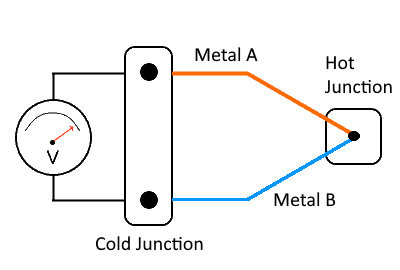Thermo Couples: Principles, Applications, and Recent Advancements
Thermocouples are vital devices used in various industries to measure temperature accurately and reliably. As a fusion of thermoelectric principles, these temperature sensors find applications across multiple sectors, ranging from manufacturing and aerospace to research and development. In this comprehensive article, we will delve into the principles that underpin thermocouples, explore their diverse applications, and uncover the latest advancements in the field as of 2023. This article is tailored for engineering professionals and college university students seeking in-depth insights into this fascinating technology.
What is a Thermocouple?
A thermocouple is a temperature sensor that operates based on the Seebeck effect. When two dissimilar conductors are joined together at two different temperatures, an electromotive force (EMF) is generated, which can be measured to determine the temperature accurately. Thermocouples are widely used due to their durability and accuracy in various applications.

Thermocouple Thermometer and Its Types
A thermocouple thermometer is a device that employs a thermocouple to measure temperature. There are various types of thermocouples, including K-type thermocouples, J-type thermocouples, and more. Each type has specific properties and applications, making them suitable for different temperature ranges and environments.
Working Principle of Thermocouples
The working principle of thermocouples is based on the Seebeck effect. When the two dissimilar conductors of a thermocouple are exposed to different temperatures, a potential difference is generated, creating an electric circuit. By measuring this voltage, the temperature can be accurately determined.
K Type Thermocouple: Material and Applications
The K-type thermocouple is one of the most commonly used thermocouples. It is made of chromel (Nickel-Chromium) and alumel (Nickel-Aluminum), offering a wide temperature range and high accuracy. The K-type thermocouple finds applications in various industries, including HVAC, manufacturing, and scientific research.
Thermocouples in Physics and Sensor K Type
In physics, thermocouples are extensively used for temperature measurements in experiments and research. The K type thermocouple, a common sensor type, is known for its versatility, making it suitable for diverse physics applications.
Thermo Couples' Applications
Industrial Applications
Thermo couples play a fundamental role in industrial processes. They are extensively used in monitoring and controlling temperature in chemical plants, oil refineries, and power generation facilities. Due to their durability and accuracy, thermo couples contribute significantly to process optimization, ensuring product quality and safety.
Aerospace and Aviation
In the aerospace industry, precise temperature monitoring is essential for aircraft engines, fuel systems, and avionics. Thermo couples provide real-time temperature data, allowing engineers to make critical decisions and enhance the overall safety and performance of aircraft.
Medical and Healthcare
Thermo couples are employed in medical devices, such as thermometers and patient monitoring systems. Their fast response time and reliability make them an indispensable tool in healthcare settings, enabling accurate diagnosis and treatment.
Research and Development
Scientists and researchers benefit from thermo couples when studying various materials and conducting experiments. Their ability to measure temperature across a wide range makes them valuable tools in the pursuit of scientific advancements.
Recent Advancements in Thermo Couples
Nanotechnology Integration
In recent years, researchers have explored integrating nanotechnology into thermocouples to enhance their sensitivity and response time. Nanoscale materials exhibit unique properties that can revolutionize temperature sensing capabilities.
Wireless Thermo Couples
Wireless technology has brought remarkable convenience to temperature monitoring systems. Advanced thermocouples now come with wireless connectivity options, allowing remote data collection and real-time analysis through cloud-based platforms.
Self-Powered Thermo Couples
In 2023, self-powered thermocouples emerged as a significant development. These devices can generate their power using energy harvesting techniques, eliminating the need for external power sources and enabling sustainable, autonomous temperature measurements.
IoT Integration
The Internet of Things (IoT) has made its way into thermocouples, transforming them into intelligent sensors capable of communicating with other devices and systems. IoT integration provides enhanced data analytics and automated temperature control.
Tips for Optimizing Thermo Couple Performance
Calibration and Maintenance
Regular calibration and maintenance are essential for accurate temperature measurements. Engineering professionals should adhere to best practices to ensure the reliability and longevity of thermocouples.
Selecting the Right Thermo Couple Type
Different applications demand specific thermocouple types. Understanding the properties of various thermo couple materials will help engineering professionals choose the most suitable option for their intended purpose.
Consider Environmental Factors
Environmental conditions can affect thermo couple performance. Account for factors like temperature range, corrosive environments, and vibration when selecting and installing thermo couples.
Conclusion
Thermo couples continue to be indispensable tools for temperature measurement in diverse industries and applications. By understanding the principles behind thermo couples and staying updated on the latest advancements, engineering professionals and college university students can harness the full potential of this technology. As thermo couples embrace nanotechnology, wireless connectivity, and IoT integration in 2023, the future promises even more exciting possibilities for precise and efficient temperature monitoring. By applying the tips for optimization, professionals can ensure that thermo couples perform optimally, providing valuable insights to users and driving advancements across various fields.
